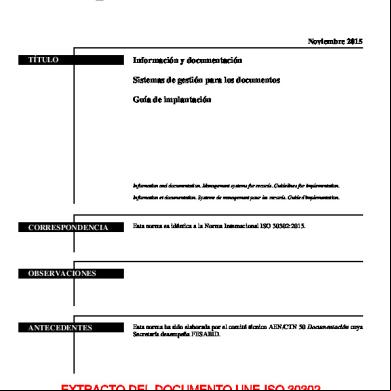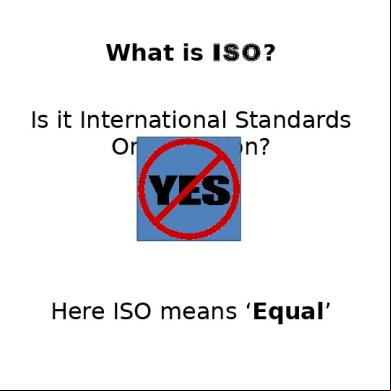Iso 17640-2010-ut 5f3a6g
This document was ed by and they confirmed that they have the permission to share it. If you are author or own the copyright of this book, please report to us by using this report form. Report 3i3n4
Overview 26281t
& View Iso 17640-2010-ut as PDF for free.
More details 6y5l6z
- Words: 591
- Pages: 1
UT of thickness greater than or equal to 8 mm
Test object temperatures from 0 °C to 60 °C
Scope
Primarily intended for use on full penetration welded ts where both the welded and parent material are ferritic Ultrasonic sound velocity of (5920 ±50) m/s for longitudinal waves and (3255 ±30) m/s for transverse waves. (If materialdependent ultrasonic values are specified) Selection of testing levels A, B, C, D (Testing levels for various types of welded ts )
Perosonnel qualification
Perosonnel qualification in accordance with ISO 9712 or EN 473 or equivalent in the relevant industrial sector.
Equipment
Any equipment used for testing in conjunction with this International Standard shall comply with the requirements of EN 12668 (all parts)
Probe Frequency
Transducer frequency 2 MHz to 5 MHz
Probe Angle
When testing is carried out with transverse waves and techniques that require the ultrasonic beam to be reflected from an opposite surface, care shall be taken to ensure that the angle between the beam and the normal to the opposite reflecting surface is between 35° and 70° When the use of two or more probe angles is specified, the difference between the nominal beam angles shall be 10° or greater Angles of incidence at the probe and opposite reflecting surface, when curved, may be determined by drawing a sectional view of the weld or in accordance with the techniques given in EN 583-2
Couplant
The coupling media shall be in accordance with EN 583-1. The coupling medium used for range and sensitivity setting and for the test shall be the same.
Examination Coverage
The testing volume is defined as the zone which includes weld and parent material for at least 10 mm on each side of the weld, or the width of the heat-affected zone, whichever is greater.
NDT Ultrasonic Testing
Sensitivty calibration deviation; 1) Deviations ≤ 4 dB Setting shall be corrected before the testing is continued. 2) Reduction of the sensitivity ˃4 dB Setting shall be corrected and all testing carried out with the equipment over the previous period shall be repeated. 3) Increase in sensitivity ˃4 dB Setting shall be corrected and all recorded indications shall be re-examined.
Range Calibration deviation 1) Deviations ≤2% of the range, setting shall be corrected and testing shall be carried out. 2) Deviations ˃2% of the range, setting shall be corrected and testing shall be carried out with the equipment over the previous period shall be repeated.
Calibration & Calibration Block Sensitivity Setting One of the following techniques for setting the reference shall be used. a) Technique 1: the reference is a distance-amplitude curve (DAC) for side-drilled holes of diameter 3 mm. b) Technique 2: the references for transverse and longitudinal waves using the distance gain size (DGS) system based on the diameter of the disk-shaped reflector (DSR) are given in Tables 3 and 4 respectively. c) Technique 3: the reference notch shall be 1 mm wide, rectangular, with a depth of 1 mm. This technique applies only for the thickness range 8 mm ≤ t < 15 mm and for beam angles ≥70°. d) Technique 4: for the tandem technique, the reference is a flat bottomed hole of 6 mm diameter (for all thicknesses), perpendicular to the scanning surface. This technique is applicable onlyfor beam angle 45° and thickness t ≥ 15 mm. The length of the side-drilled holes and notches shall be greater than the width of the sound beam measured at -20 dB
Evaluation
The evaluation levels for techniques 1 to 4 are given in ISO 11666:2010, Table A.1
Test object temperatures from 0 °C to 60 °C
Scope
Primarily intended for use on full penetration welded ts where both the welded and parent material are ferritic Ultrasonic sound velocity of (5920 ±50) m/s for longitudinal waves and (3255 ±30) m/s for transverse waves. (If materialdependent ultrasonic values are specified) Selection of testing levels A, B, C, D (Testing levels for various types of welded ts )
Perosonnel qualification
Perosonnel qualification in accordance with ISO 9712 or EN 473 or equivalent in the relevant industrial sector.
Equipment
Any equipment used for testing in conjunction with this International Standard shall comply with the requirements of EN 12668 (all parts)
Probe Frequency
Transducer frequency 2 MHz to 5 MHz
Probe Angle
When testing is carried out with transverse waves and techniques that require the ultrasonic beam to be reflected from an opposite surface, care shall be taken to ensure that the angle between the beam and the normal to the opposite reflecting surface is between 35° and 70° When the use of two or more probe angles is specified, the difference between the nominal beam angles shall be 10° or greater Angles of incidence at the probe and opposite reflecting surface, when curved, may be determined by drawing a sectional view of the weld or in accordance with the techniques given in EN 583-2
Couplant
The coupling media shall be in accordance with EN 583-1. The coupling medium used for range and sensitivity setting and for the test shall be the same.
Examination Coverage
The testing volume is defined as the zone which includes weld and parent material for at least 10 mm on each side of the weld, or the width of the heat-affected zone, whichever is greater.
NDT Ultrasonic Testing
Sensitivty calibration deviation; 1) Deviations ≤ 4 dB Setting shall be corrected before the testing is continued. 2) Reduction of the sensitivity ˃4 dB Setting shall be corrected and all testing carried out with the equipment over the previous period shall be repeated. 3) Increase in sensitivity ˃4 dB Setting shall be corrected and all recorded indications shall be re-examined.
Range Calibration deviation 1) Deviations ≤2% of the range, setting shall be corrected and testing shall be carried out. 2) Deviations ˃2% of the range, setting shall be corrected and testing shall be carried out with the equipment over the previous period shall be repeated.
Calibration & Calibration Block Sensitivity Setting One of the following techniques for setting the reference shall be used. a) Technique 1: the reference is a distance-amplitude curve (DAC) for side-drilled holes of diameter 3 mm. b) Technique 2: the references for transverse and longitudinal waves using the distance gain size (DGS) system based on the diameter of the disk-shaped reflector (DSR) are given in Tables 3 and 4 respectively. c) Technique 3: the reference notch shall be 1 mm wide, rectangular, with a depth of 1 mm. This technique applies only for the thickness range 8 mm ≤ t < 15 mm and for beam angles ≥70°. d) Technique 4: for the tandem technique, the reference is a flat bottomed hole of 6 mm diameter (for all thicknesses), perpendicular to the scanning surface. This technique is applicable onlyfor beam angle 45° and thickness t ≥ 15 mm. The length of the side-drilled holes and notches shall be greater than the width of the sound beam measured at -20 dB
Evaluation
The evaluation levels for techniques 1 to 4 are given in ISO 11666:2010, Table A.1





